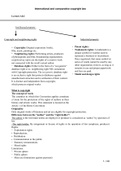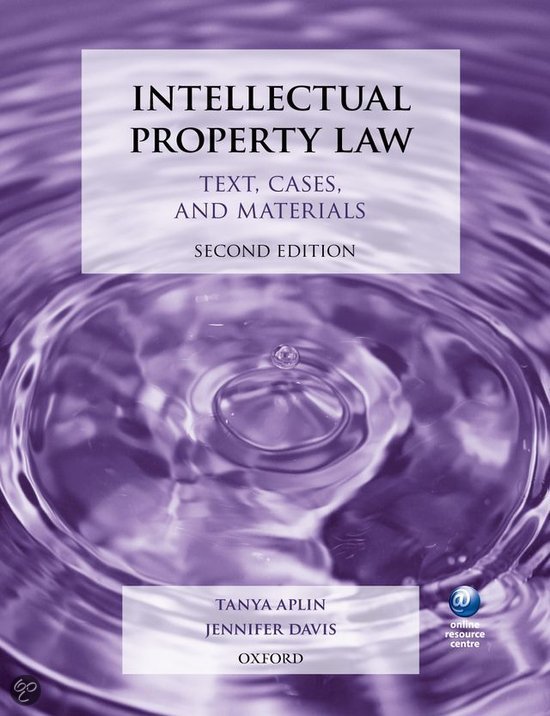International and comparative copyright law
Lecture 1&2
Intellectual property
Copyright and neighboring rights Industrial property
- Copyright: Original expression: books, - Patent rights:
film, music, paintings etc. - Trademark rights: A trademark is a
- Neighboring rights: Performing artists, producers unique symbol or word(s) used to
of phonograms and film, broadcasting organizations. represent a business or its products.
neighbouring rights are the rights of a creative work Once registered, that same symbol or
not connected with the work's actual author series of words cannot be used by any
- Database rights: Either in the form of a “sui generis” other organization, forever, as long as it
database right or as neighboring right NB: cumulation remains in use and proper paperwork
with Copyright protection. The sui generis database right and fees are paid.
is an exclusive right that protects databases against - Model and design rights
unauthorised extraction and re-utilisation of their content.
It is distinct and independent from copyright,
which protects original works.
What is copyright
The concept of work:
The countries to which this Convention applies constitute
a Union for the protection of the rights of authors in their
literary and artistic works. This statement is located on the
Article 1 of the Berne Convention.
Originality:
Only original works of literature and art are eligible for copyright protection.
Difference between the “author” and the “right holder”:
The author is the real make unless an employer or producer is considered as ‘author’ by operation of
law
The right holder: By assignment or license of rights or by operation of law (employer, producer)
Rights:
- Exploitation rights
• Reproduction,
• Distribution
• Communication to the public
- Statutory remunerations
- Moral rights
Limitations:
- Private sphere
- Public sphere
- Mass use (limitations against payment)
, International and comparative copyright law
Duration of the copyright
Berne Convention:
The exclusive right lasts until at least 50 years after the death of the author (“p.m.a.”, post mortem
auctoris)
Europe: 70 years p.m.a. (art. 1 Term Directive)
US: 70 years p.m.a.
International sources of copyright law
Berne Convention:
Article 1: The countries to which this Convention applies constitute a Union or the protection of the
rights of authors in their literary and artistic works.
Article 2: Literary and artistic means that every production in these domaines whatever the form of
expression is.
Article 3: The protection of this Convention shall apply to:
(a) authors who are nationals of one of the countries of the Union, for their works, whether
published or not;
(b) authors who are not nationals of one of the countries of the Union, for their works first
published in one of those countries or simultaneously in a country outside the Union and in a
country of the Union.
(c) Authors who are not nationals [..] but who have their habitual residence in one of them shall,
for the purposes of this Convention, be assimilated to nationals of that country.
Simultaneous publication: A work shall be considered as having been published simultaneously in
several countries if it has been published in two or more countries within thirty days of its first
publication.
Article 5: Authors shall enjoy in countries other than the country of origin, the rights which their
respective laws do now or may hereafter grant to their nationals (“national treatment”)
as well as the rights specially granted by this Convention: ) Protection in the country of origin is
governed by domestic law. However, when the author is not a national of the country of origin of
the work for which he is protected under this Convention, he shall enjoy in that country the same
rights as national authors
Country of origin:
(A) In the case of works first published in a country of the Union, that country; in the case of
works published simultaneously in several countries of the Union which grant different terms
of protection, the country whose legislation grants the shortest term of protection;
(B) In the case of works published simultaneously in a country outside the Union and in a country
of the Union, the latter country;
(C) in the case of unpublished works or of works first published in a country outside the Union,
without simultaneous publication in a country of the Union, the country of the Union of which
the author is a national, provided that:
, International and comparative copyright law
Article 6: Moral rights
Independently of the author's economic rights, and even after the transfer of the said rights,
the author shall have the right to claim authorship of the work and to object to any distortion,
mutilation or other modification of, or other derogatory action in relation to, the said work, which
would be prejudicial to his honor or reputation.
Article 7: Terms of protection
- The term of protection granted by this Convention shall be the life of the author and fifty years
after his death. (“50 yrs p.m.a.”)
- Term Directive 2006/116 made that 70 years in Europe
- It shall be a matter for legislation in the countries of the Union to determine the term of
protection of photographic works and that of works of applied art in so far as they are protected
as artistic works; however, this term shall last at least until the end of a period of twenty-five
years from the making of such a work. For models and designs is much more reduced
compared to other works.
Models and design is a very special element. You have national laws on model and designs. Outside
the EU they can take every conveyable form much more diverse than the copyright protection.
There is a possibility that you can get IP protection for models and designs via trademark law.
Article 8: right to translation
The exclusive right of making and of authorizing the translation
Article 12: right to adaptation and alteration
Authors of literary or artistic works shall enjoy the exclusive right of authorizing adaptations,
arrangements and other alterations of their works.
Article 9: right to reproduction
The exclusive right of authorizing the reproduction[…] in any manner or form.
Article 11: public performance
Exclusive right to authorize: the public performance of their works, including such public
performance by any means or process; any communication to the public of the performance of their
works.
TRIPs
The Agreement on Trade-Related Aspects of Intellectual Property Rights (TRIPS) is an
international legal agreement between all the member nations of the World Trade Organization
(WTO). It sets down minimum standards for the regulation by national governments of many forms
of intellectual property (IP) as applied to nationals of other WTO member nations. Specifically,
TRIPS requires WTO members to provide copyright rights. TRIPs is considered as an update to the
Berne Convention as the latter is signed long time ago.
‘Trade Related Intellectual Property Rights
Effective enforcement in horizontal relations
Dispute settlement system rules of substantive copyright law:





